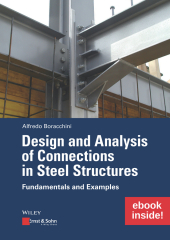 Neuerscheinungen 2018Stand: 2020-02-01 |
Schnellsuche
ISBN/Stichwort/Autor
|
Herderstraße 10
10625 Berlin
Tel.: 030 315 714 16
Fax 030 315 714 14
info@buchspektrum.de |

Alfredo Boracchini
Design and Analysis of Connections in Steel Structures
Fundamentals and Examples (incl. E-Book als PDF)
1. Auflage. 2018. 380 S. 50 Tabellen. 240 mm
Verlag/Jahr: ERNST & SOHN 2018
ISBN: 3-433-03226-2 (3433032262)
Neue ISBN: 978-3-433-03226-8 (9783433032268)
Preis und Lieferzeit: Bitte klicken
The book introduces all aspects needed for connection design and analysis in steel structures. This is treated making comparison among the methodologies used in the engineering practice, e.g. Eurocode, AISC, DIN, BS. With practice examples and details.
(Package: Print + ePDF)
Preface
Abbreviations
Introduction
1 Structural design basic principles relative to joints in steel structures
1.1 Hinges and joints capable of resisting a bending moment
1.2 The plastic hinge
2 Basic concepts for the analysis of connections
2.1 Connection types
2.2 Outline of design and actions
2.3 Forces distribute proportionally to stiffness
2.4 Ductility
2.5 Load path
2.6 Ignorance of the path of the forces
2.7 Constraints
2.8 Methods to define the ultimate limit states in the joints
2.9 Resistance of bolts
2.10 Yield line
2.11 Eccentric connections
2.12 Economics, repetition, simplicity
2.13 Man-hours, material weight
2.14 Diffusion angles
2.16 Transfer forces
2.15 Tensioning of bolts and resistance
2.17 Behavior of a bolted joint shear
2.18 Behavior of a bolted joint in traction
3 The limit states for the components of the connection
3.1 Capacity of deformation (rotation) and relative stiffness
3.2 Inelastic deformations at the bolt hole
3.3 Bolt shear rupture
3.4 Bolt tensile rupture
3.5 Breaking bolt with a combination of tension and shear
3.6 Resistance to friction bolts
3.7 Bolt bearing and tearing
3.8 Block shear (or block tearing)
3.9 Weld rupture
3:10T-stub, with and without prying effect
3.11 Punching shear
3.12 Equivalent systems in parallel
3:13 Web panel shear
3.14 Transversal compression over web
3:15 Transversal tension over column web
3.16 Web and flange compression
3:17 Tension on beam web
3.18 Plate resistance
3.19 Notched profiles
3.20 Local capacity
3:22 Structural integrity
3.23 Ductility
3:24 Laminated plate tearing
3.25 Other states limit in connection with cold formed profiles or sheets
3.26 Fatigue
3:27 Limit states for other connected related materials
4 types and analysis with calculation examples
4.1 Common symbols
4.2 Eccentric bolted joint in the plane of contact
4.3 Eccentric bolted connection perpendicular to the contact plane gravity method
4.4 Base plate with cast anchor bolts4.5 chemical or mechanical anchors
4.6 Fin plate
4.7 Double bolted plate
4.8 Flexible end plate
4.9 Clip angles
4:10 Truss joints
4.10.1 connecting plate
4:11 Connection leaning on a column
4:12 Rigid end plate
4:13 Splice
4.13.1 calculation model and limit states
4.13.2 rotation capacity, structural integrity, ductility
4.13.3 column splice example according to is800
4:14 Brace joints
4.14.1 american methods: ufm and kiss
4.14.2 practical advice
4.14.3 bracing friction connection example according to csa s16
4.15 Chair support
4.16 Connections for purlins
4:17 Tubular welded joints
4:18 Joints in steel-concrete composite structures
4:19 joints with welding and bolting working in parallel
4:20 Expansion joints
4:21 Perfect hinges
4:22 Sliding details
4:23 Rivets
4:24 Joints for seismic applications
4.24.1 rigid end plate
4.24.2 braces
4.24.3 eccentric braces with "link"
4.24.4 base plate
5 selection of the right connection
5.1 Priority to those who produce and erect
5.2 Considerations about the pros and cons of the various connection types
5.3 Organization of the workshop
5.3.1 plates or sheets
5.3.2 concept of "picking up a piece"
5.4 Cultural elements
6 tips, notes and practices
6.1 Project standardization
6.2 Hole dimensions
6.3 Installation
6.4 Maneuvering
6.5 Spacing and distances between bolts
6.6 Root radius overlap
6.7 Notches
6.8 Pretensioning
6.9 Washers
6:10 Dimensions for screws, nuts and washers
6.11 Reusing bolts
6.12 Bolts classes
6:13 Shims
6:14 Galvanization
6.15 Other treatments after manufacturing
6:16 Camber
6:17 Grouting base plates
6.18 Graphical representation of joints and bolts
6:19 Field welding
6:20 Special couplings (inclined)
7 Sketches of possible joint applications
Bibliography
Index of tables
Index


